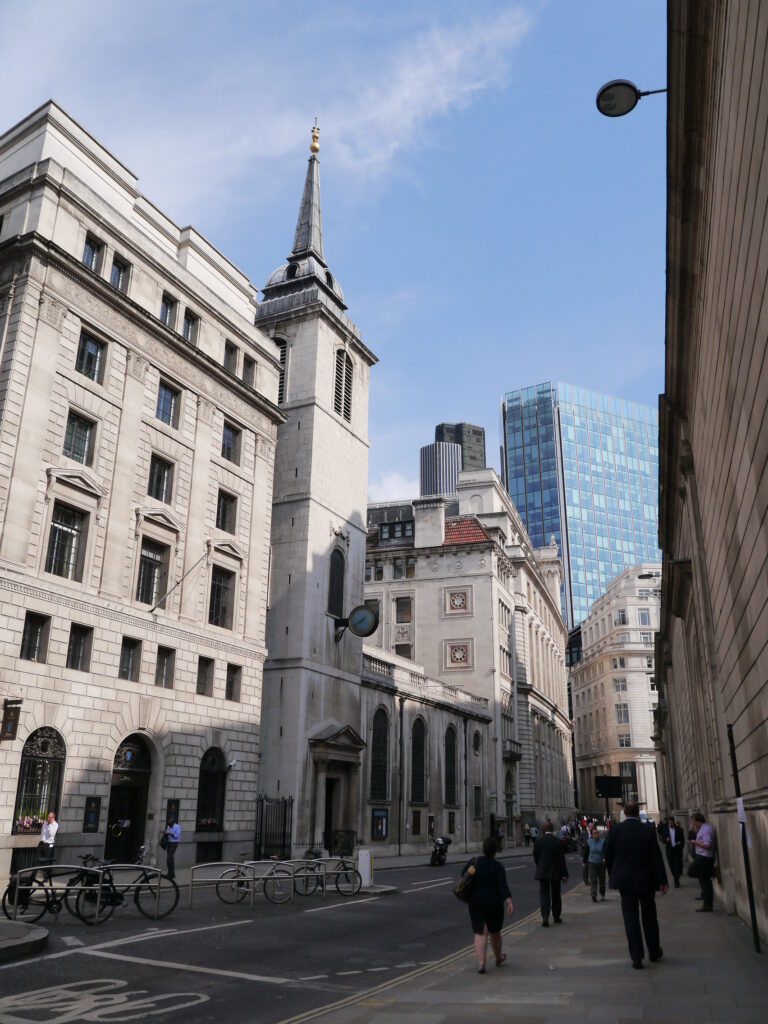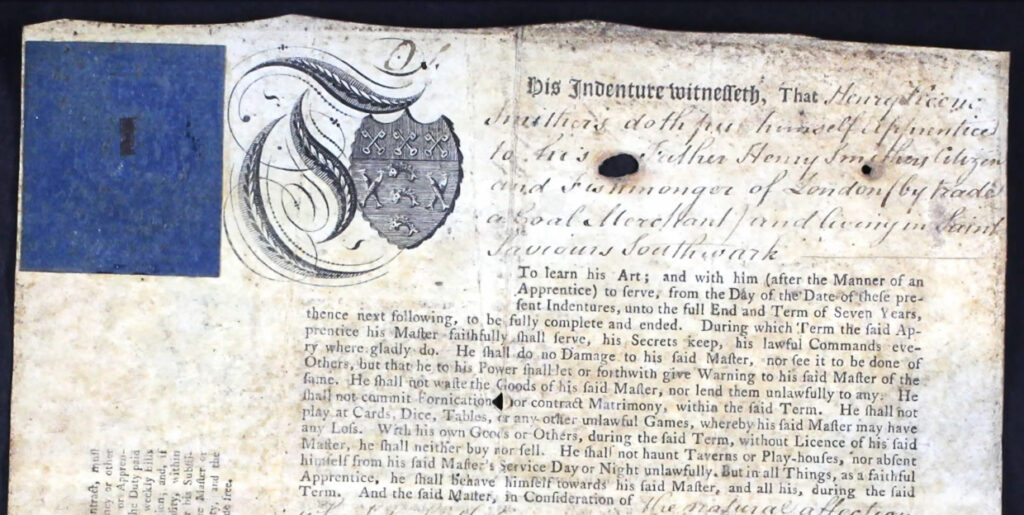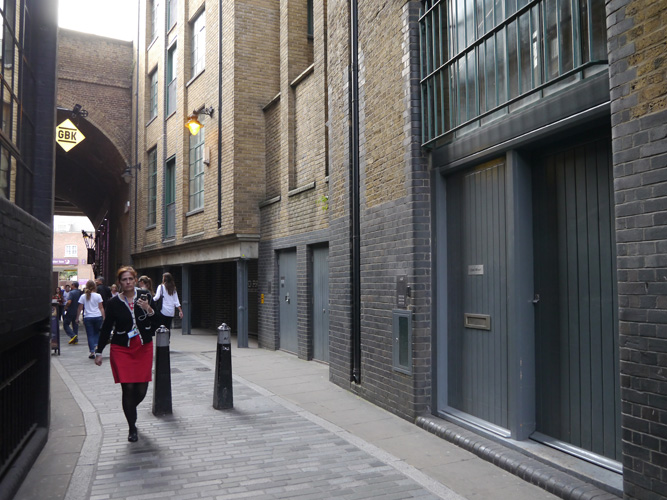Many marriage records are just that: the name of the bride, name of the groom, date of the event and the location. Other records include additional information that helps the genealogist track down earlier generations or solve various mysteries.
Such was the case of the 1783 marriage license issued to my four-times great grandparents Henry Smithers and Sophia Papps. Both were minors (they were ages twenty and nineteen respectively) when they wed, so their fathers had to consent to their marriage and pay £200 — a very hefty fee — for the license. With the names and occupations of their fathers, I was able to follow both families back one more generation.
Henry and Sophia were married on 22 Feb.1783 at Sophia’s parish church, St. Matthew, in Bethnal Green, a town east of London. The associated allegation document reveals that Sophia’s father was Richard Papps, a merchant, and Henry’s father was Joseph Smithers, a schoolmaster at St. Margaret Lothbury Academy, London.1
With this information, I was able to confirm that Sophia’s parents were Richard and Mary Papps. Richard Papps had married Mary Smith in Salisbury on 1 Aug. 1758.2 Over the next eight years, the couple had six children although at least one of them died. Sophia was baptized on 9 Nov.17633 at St. Thomas Church, Salisbury, Wiltshire. Richard had a clothing business in Salisbury, which is near Stonehenge, in southwest England.

Henry’s parents, Joseph Smithers and Martha Keene, were wed on 19 March 1760 at St. Mary, Newington, Southwark, Surrey, on the south shore of the Thames River near London Bridge. Their marriage license revealed that Joseph was from the ancient parish of St. Margaret Lothbury in central London, and that Martha was the daughter of John and Alice Keene. Finding the name Keene was interesting because several Smithers family members in later generations had Keene as a middle name.
The fact that Joseph was a schoolmaster at St. Margaret Lothbury suggests that he was the son of the Joseph Smithers mentioned in a list of obituaries in the Gentleman’s Magazine, 3 July 1789. That obituary read, “Mr. Jos. Smithers, master of the academy, Lothbury.“ So far I have not found any other information about him, or about the academy. St. Margaret Lothbury church still exists.
Henry Smithers was born in Crooked Lane, St Michael Parish, City of London, on 7 Aug. 1762, and he had one sibling, Martha, two years his junior. Both births were registered on 10 June 1776,4 according to the England & Wales, Non-Conformist and Non-Parochial Registers.
In 1787, Martha Smithers married John Hemming, a London coal merchant and property manager, and a convert to non-conformity. They had 10 children, and some of their descendants live in Canada today. Martha died in 1833. As for Henry, he became a coal merchant in London. He also loved to write poetry and non-fiction books. He died in 1828, age 65, in Liverpool, where his son John Hampton Smithers lived. I do not know whether Henry and Sophia were also living in Liverpool or just visiting. He was buried on 8 April 1828 at St, Mary’s Church Edge Hill, Walton Parish, Lancashire.5
Sophia lived another 16 years. Unless I am mistaken, she appeared on the 1841 census, age 77, living with a family named Richardson6 and when she died she was living in the St. Pancras area of London. She was buried on 3 Jan. 1845 at All Souls’ Cemetery, also known as Kensal Green Cemetery.
Photo credit: Janice Hamilton
Research remarks
At that time, the minister typically announced a coming marriage (this was called reading the banns) at church to give people an opportunity to express their opposition to the union. Couples could bypass this step by paying a fee for a marriage license. A marriage allegation is a sworn statement in connection with the license application in which the couple state there is no known reason for the marriage not to take place.
Henry was a non-conformist, meaning he was a member of a Protestant denomination, such as the Baptist or Congregational church, rather than the official Church of England. This is another reason why Henry would have had to obtain a marriage license to marry Sophia.
The 1783 marriage by licence of Henry Smithers and Sophia Papps at St. Matthew Church, Bethnel Green, can be found in Ancestry’s database London, England, Marriages and Banns, 1754-1921. There are two allegation statements related to the same marriage in Ancestry’s database London and Surrey, England, Marriage Bonds and Allegations, 1597-1921. One can be found under Henry Smithers’ name, the other is indexed under the name Joseph Smithers.
An image of the Gentleman’s Magazine obituary for Joseph Smithers can be found on the Smither, Smithers Smyther Public Member Tree, maintained on Ancestry by Michael Smither. http://trees.ancestry.com/tree/49405444/person/27777427113/media/e6a90ca9-da31-4152-8396-7ab6f7eb4db0?pg=32768&pgpl=pid
The information about John Hemming was provided to me in an e-mail in November 2014 by descendant Graham Jeffery, who lives in Ontario. I will write a separate article about Henry’s and Sophia’s six children, and later I will write about Henry’s career and interests.
Footnotes
- “London and Surrey, England, Marriage Bonds and Allegations, 1597-1921” database, Ancestry.com (http://www.ancestry.com : accessed Dec. 16 2014), entry for Joseph Smithers, 22 February 1783, citing Marriage Bonds and Allegations. London, England: London Metropolitan Archives.
- “England & Wales Marriages, 1538-1940 “ database, Ancestry.com (http://www.ancestry.com : accessed Dec. 16 2014), entry for Richard Papps, 1 Aug. 1758, Salisbury; citing Salisbury, Wiltshire, England; Collection: St Thomas; 1570 – 1906
- “London, England, Baptisms, Marriages and Burials, 1538-1812” database, Ancestry.com(http://www.ancestry.com: accessed 29 Nov. 2014), entry for Joseph Smithers, 19 March, 1760, Southwark; citing Church of England Parish Registers, 1538-1812. London, England: London Metropolitan Archives; St Mary, Newington, Composite register: marriages, banns, May 1754-Jul 1769, P92/MRY/010.
- “England & Wales, Non-Conformist and Non-Parochial Registers, 1567-1970”, database, Ancestry.com (http://www.ancestry.com: accessed 1 Dec. 2014), entry for Henry Smithers, 7 Aug. 1762, London; citing: General Register Office: Registers of Births, Marriages and Deaths surrendered to the Non-parochial Registers Commissions of 1837 and 1857. Records of the General Register Office, Government Social Survey Department, and Office of Population Censuses and Surveys, Registrar General (RG) 4. The National Archives, Kew, England.
- “Lancashire, England, Deaths and Burials, 1813-1986” database, Ancestry.com (http://www.ancestry.com: accessed 1 Dec. 2014), entry for Henry Smithers, 8 April 1828, Lancashire; citing: Lancashire Anglican Parish Registers. Preston, England: Lancashire Archives.
- “1841 England Census”database, Ancestry.com (http://www.ancestry.com: accessed 14 Dec. 2014), entry for Sophia Smithers, 1841, London; citing: Census Returns of England and Wales, 1841. Kew, Surrey, England: The National Archives of the UK (TNA): Public Record Office (PRO), 1841.


